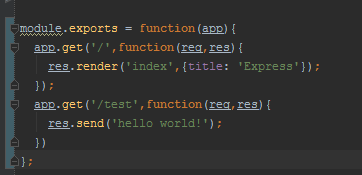1. 路由控制的工作原理
//routes/index.js中的代码
//访问主页时,调用ejs模板引擎,渲染index.ejs模板文件,生成静态页面,并显示在浏览器中。
router.get('/', function(req, res) { //捕获访问主页的GET请求 res.render('index', { title: 'Express' }); });
官方给出的写法是在 app.js 中实现了简单的路由分配,然后再去 index.js 中找到对应的路由函数,最终实现路由功能。
我们不妨把路由控制器和实现路由功能的函数都放到 index.js 里,app.js 中只有一个总的路由接口。
修改后的app.js
1 //通过require()加载express、path模块。以及routes文件夹下的index.js 和user.js路由文件 2 var express = require('express'); 3 var path = require('path'); 4 var favicon = require('serve-favicon'); 5 var logger = require('morgan'); 6 var cookieParser = require('cookie-parser'); 7 var bodyParser = require('body-parser'); 8 //加载路由文件 9 var routes = require('./routes/index'); 10 var users = require('./routes/users'); 11 12 var app = express(); //生成一个express实例app 13 14 app.set('port', process.env.PORT||3000);//第一章 添加 15 // view engine setup 16 app.set('views', path.join(__dirname, 'views'));//设置 views 文件夹为存放视图文件的目录, 即存放模板文件的地方,__dirname 为全局变量,存储当前正在执行的脚本所在的目录。 17 app.set('view engine', 'ejs');// 设置视图模板引擎为 ejs 18 19 // uncomment after placing your favicon in /public 20 //app.use(favicon(__dirname + '/public/favicon.ico')); //设置/public/favicon.ico为favicon图标 21 app.use(logger('dev'));//加载日志中间件 22 app.use(bodyParser.json());//加载解析json的中间件 23 app.use(bodyParser.urlencoded({ extended: false }));//加载解析urlencoded请求体的中间件 24 app.use(cookieParser());//加载解析cookie的中间件 25 app.use(express.static(path.join(__dirname, 'public')));//设置public文件夹为存放静态文件的目录 26 27 ////路由控制器 第一章 删减 28 //app.use('/', routes); 29 //app.use('/users', users); 30 31 //第一章 添加 32 routes(app); 33 app.listen(app.get('port'),function(){ 34 console.log('Express server listening on port' + app.get('port')); 35 }); 36 37 // catch 404 and forward to error handler 捕获404错误,并转发到错误处理器。 38 app.use(function(req, res, next) { 39 var err = new Error('Not Found'); 40 err.status = 404; 41 next(err); 42 }); 43 44 // error handlers 45 46 // development error handler 47 // will print stacktrace 48 //开发环境下的错误处理器,将错误信息渲染error模版并显示到浏览器中。 49 if (app.get('env') === 'development') { 50 app.use(function(err, req, res, next) { 51 res.status(err.status || 500); 52 res.render('error', { 53 message: err.message, 54 error: err 55 }); 56 }); 57 } 58 59 // production error handler 60 // no stacktraces leaked to user 61 //生产环境下的错误处理器,将错误信息渲染error模板并显示到浏览器中。 62 app.use(function(err, req, res, next) { 63 res.status(err.status || 500); 64 res.render('error', { 65 message: err.message, 66 error: {} 67 }); 68 }); 69 70 //module.exports = app;//导出app实例并供其它模块使用
index.js
1 //var express = require('express'); 2 //var router = express.Router(); //创建路由实例 3 // 4 ///* GET home page. */ 5 //router.get('/', function(req, res) { //捕获访问主页的GET请求 6 // res.render('index', { title: 'Express' }); 7 //}); 8 // 9 //module.exports = router;//导出路由,并在app中以app.use('/',routes)加载 10 11 12 module.exports = function(app){ 13 app.get('/',function(req,res){ 14 res.render('index',{title: 'Express'}); 15 }); 16 app.get('/test',function(req,res){ 17 res.send('hello world!'); 18 }) 19 };
2. 路由规则
express 封装了多种 http 请求方式,主要使用 app.get() 和app.post()
//第一个参数为请求的路径,第二个参数为回调函数(包括req和res两个参数,分别代表请求信息和响应信息)。
app.get(**,function(req,res){ ***}); app.post(**,function(req,res){ ***});
路径请求及对应的获取路径有以下几种形式:
req.query: 处理 get 请求,获取 get 请求参数req.params: 处理 /:xxx 形式的 get 或 post 请求,获取请求参数req.body: 处理 post 请求,获取 post 请求体req.param(): 处理 get 和 post 请求,但查找优先级由高到低为 req.params→req.body→req.query
3. 添加路由规则
浏览器打开http://localhost:3000/ 返回“Welcome to Express”界面
打开http://localhost:3000/test, 返回 “404 Not Found”
此时,添加路由:
在index.js 中,添加响应,如下:

之后,打开http://localhost:3000/test,就可以返回“hello world!”界面了。
【上述test,看完效果还回复原代码】
4. 模板渲染ejs
//__dirname+'/views'为存放视图文件的目录 app.set('views', __dirname + '/views'); //设置模板引擎为ejs app.set('view engine', 'ejs');
ejs 的标签系统非常简单,它只有以下三种标签:
- <% code %>:JavaScript 代码。
- <%= code %>:显示替换过 HTML 特殊字符的内容。
- <%- code %>:显示原始 HTML 内容。
这里我们不使用layout进行页面布局,而是使用更为简单灵活的include。include 的简单使用如下:
<%- include a %>
hello,world!
<%- include b %>